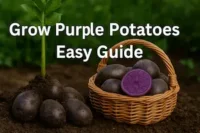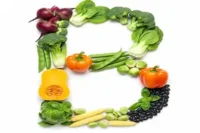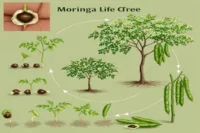7 Garlic Growing Stages: A Comprehensive Guide From Planting to Harvest
Published: 14 Jan 2024
Garlic is a widely used culinary ingredient known for its distinct aroma and health benefits. It is a species in the onion genus, Allium, closely related to the onion, shallot, leek, chive, and Chinese onion. Garlic has been utilized for its culinary and medicinal properties over the years. It is also acknowledged for its role in various traditional medicines.
In this blog post, I explore the garlic growing stages from planting to harvest, including common challenges and solutions. Understanding garlic growth stages is essential for optimal cultivation.
The growth stages of garlic involve planting, sprouting, bulb development, and finally, bulb maturity. Each stage plays a crucial role in the overall development of this flavorful and beneficial herb.

How to Grow Garlic
To grow garlic, select the suitable variety for your region, plant cloves in well-draining soil pointed end up, water regularly, mulch to conserve moisture and control weeds, fertilize sparingly, harvest when lower leaves are yellow, and cure bulbs in a warm, dry place for storage.
Types of Garlic
Generally, garlic can be categorized into two main types: softneck and hardneck.
Softneck garlic
This type is commonly found in supermarkets. It’s adaptable to various climates, stores well, and typically produces more cloves per bulb. Softneck varieties include ‘Silverskin’ and ‘Artichoke’, known for their milder flavor and pliable stalks that make them ideal for braiding.
Hardneck garlic
Conversely, this type is more robust in flavor and tends to have fewer, larger cloves. It is characterized by a central, woody stalk that shoots up and curls into a scape, which, if left on the plant, will produce flower-like bulbils. Popular hard neck varieties include ‘Rocambole,’ ‘Porcelain,’ and ‘Purple Stripe,’ each with unique flavor profiles and growing requirements.
Understanding these differences is crucial when selecting the right garlic for your garden, as each type has distinct advantages and challenges throughout the growing stages of garlic.
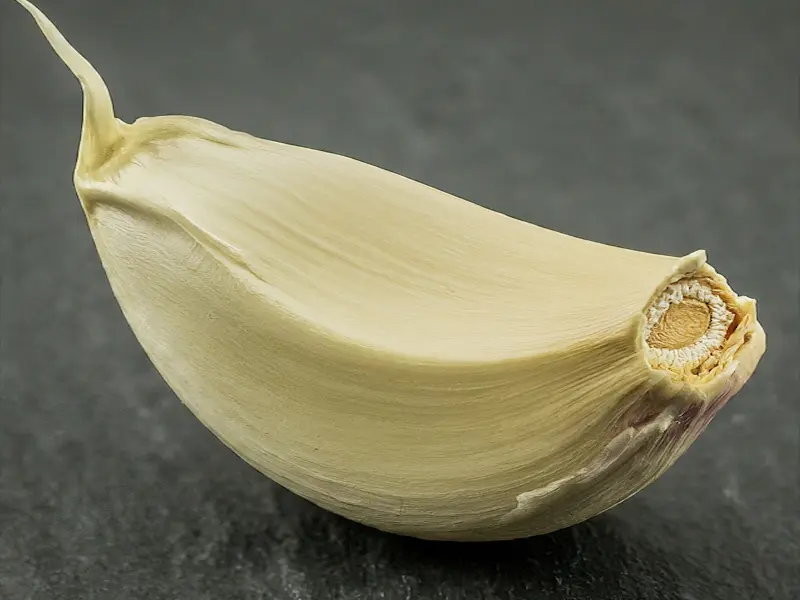
| Feature | Hardneck Garlic | Softneck Garlic |
| Climate Preference | Colder climates | Milder climates |
| Stalk | Produces a stiff, central stalk (scape) | It does not produce a central stalk; it is more flexible |
| Clove Arrangement | Slightly more challenging and needs vernalization | More cloves per bulb, but smaller |
| Flavor | More robust and complex | Generally milder |
| Storage | Shorter shelf life | Longer shelf life, better for braiding |
| Bulb Size | Generally larger | Slightly smaller |
| Growing Difficulty | Slightly more challenging and needs vernalization | It does not produce a central stalk; more flexible |
Pre-Planting Considerations
Selecting the Right Soil
The success of garlic cultivation significantly depends on the soil quality. Garlic requires well-drained, fertile rich soil in organic matter.
- Soil Texture: Loamy soil is ideal for garlic, ensuring adequate drainage and aeration. Sandy loam or silt loam soils are also suitable. Heavy clay soils should be avoided or amended, as they can retain too much moisture, leading to rot.
- Soil pH: Soil between 6.0 and 7.0 is best for Garlic growth. Slightly acidic to neutral pH levels are optimal. If the soil is too acidic (below 6.0), it can be amended with lime. For alkaline soils (above 7.0), adding sulfur or organic matter like peat moss can help lower the PH.
- Nutrient Requirements: Garlic benefits from soil rich in nutrients. Before planting, it’s advisable to incorporate organic matter such as compost or well-rotted manure into the soil. This not only improves soil fertility but also enhances soil structure.
- Soil Preparation: The soil should be well-tilled to a depth of at least 12 inches to allow for proper root development. Removing weeds and ensuring the soil is free of large clumps and stones are also crucial.
Climate and Seasonal Requirements
Garlic’s growth and yield are influenced by climate and seasonal conditions.
- Temperature: Garlic can be grown in various climates but prefers cooler temperatures during the initial growth phase and warmer, drier conditions as bulbs mature. Hardneck varieties are more suited to colder climates, while Softneck varieties prefer milder conditions.
- Planting Season: In most regions, garlic is planted in the fall. Planting garlic in the fall allows it to establish roots before the ground freezes and provides a head start in the spring. In colder climates, mulching after planting helps protect the cloves from extreme winter temperatures.
- Vernalization: Hardneck garlic requires a period of cold weather (vernalization) for proper bulb development. This bulb development is naturally achieved with fall planting in regions with cold winters.
- Spring Planting: In areas with milder winters, garlic can also be planted in early spring, as soon as the soil is workable. However, spring-planted garlic may not reach the size of fall-planted bulbs and often has a shorter storage life.
- Sunlight: Garlic requires full sun, meaning at least 6-8 hours of direct sunlight daily. Adequate sunlight is crucial for bulb development.
- Rainfall and Irrigation: While garlic needs regular watering during the growing season, overwatering or excessive rain can be detrimental, leading to rot. Drip irrigation or soaker hoses are recommended to maintain even soil moisture.
Here’s a quick table to summarize the key pre-planting considerations for garlic cultivation:
| Aspect | Details |
| Soil Texture | Preferably loamy, sandy loam, or silt loam. Avoid heavy clay soils. |
| Soil pH | Ideal pH is between 6.0 and 7.0 (slightly acidic to neutral). |
| Nutrient Requirements | Add organic matter to the soil, such as compost or well-rotted manure. |
| Soil Preparation | Till to a depth of 12 inches, ensuring removal of weeds and large clumps. |
| Temperature (Planting Season) | Cooler temperatures for initial growth; warmer, drier conditions for bulb maturation. Fall planting is common. |
| Vernalization | Required for Hardneck varieties; achieved naturally with fall planting in cold climates. |
| Spring Planting | The ideal pH is between 6.0 and 7.0 (slightly acidic to neutral). |
| Sunlight | It requires (6-8 hours of direct sunlight daily). |
| Rainfall and Irrigation | Regular watering is needed but avoids overwatering. Drip irrigation or soaker hoses are recommended. |
Introduction to Garlic Growing Stages
Garlic cultivation is a journey through several phases, each critical to developing healthy, flavorful bulbs. The garlic growing stages encompass everything from planting and germination to growth, bulb formation, maturation, and harvesting.
For the gardener, each stage presents specific tasks and opportunities to influence the growth of the garlic. Factors such as soil quality, watering, temperature, and sunlight play significant roles throughout the plant’s life. Understanding and mastering these stages allows you to optimize conditions to produce a bountiful garlic harvest.
Depending on your climate, the process begins in the fall or early spring and spans several months before culminating in the much-anticipated harvest. Let’s delve into each stage, starting with the initial phase that sets the foundation for all that follows: germination.
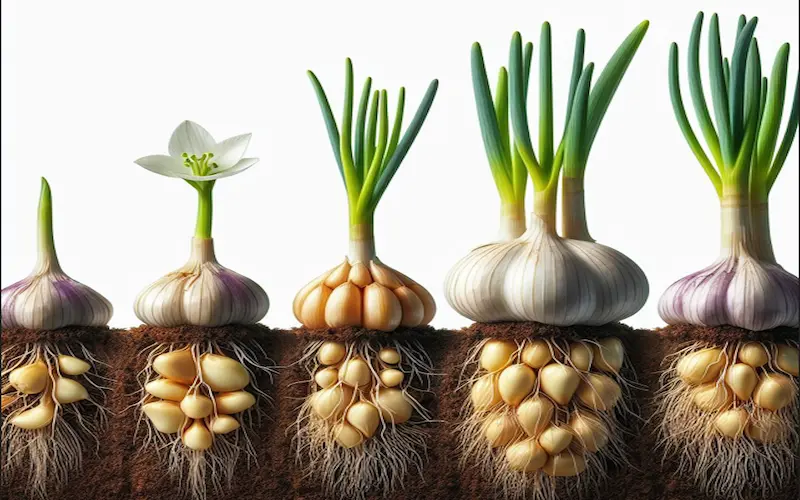
Germination Stage
The germination stage of growing garlic marks the beginning of the plant’s lifecycle. This phase starts when a garlic clove is planted in well-prepared soil. It’s a time of anticipation as the clove lies dormant beneath the surface, waiting for the right conditions to sprout.
During this stage, temperature plays a critical role. Garlic cloves require a cold period to stimulate growth, known as vernalization. In cooler climates, planting in the fall allows the cloves to experience natural cold temperatures over the winter, triggering germination in early spring. Cloves must be artificially chilled in a refrigerator before planting in warmer regions to mimic these conditions.
Moisture is another crucial factor during germination. The soil should be moist but not soggy, as too much water can cause the cloves to rot. It’s a delicate balance, requiring careful monitoring and adjustments based on weather conditions.
As the clove germinates, roots establish themselves, and a green shoot pushes through the soil surface. This first sign of life is a milestone for the grower, signalling the successful initiation of the garlic plant’s journey.
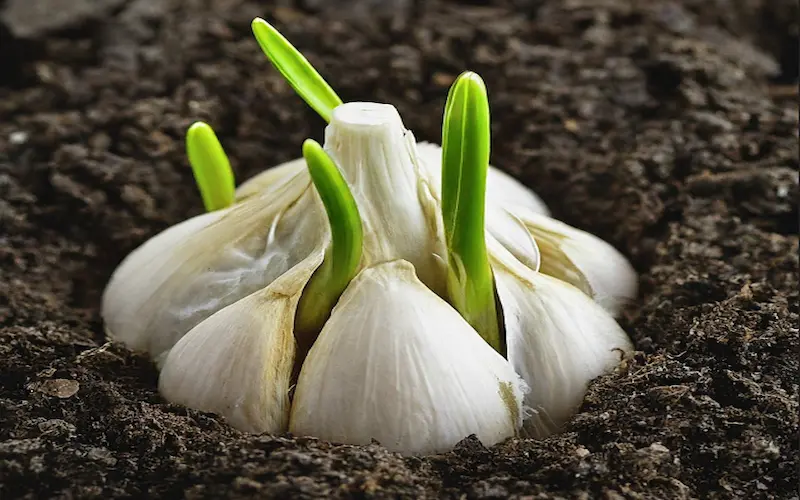
Vegetative Stage
After the initial germination, garlic enters the vegetative stage, where the focus shifts to growing strong, healthy leaves. These leaves are crucial as they photosynthesize and produce the energy needed for bulb development later in the cycle.
I promote leaf growth during this stage by ensuring the plants receive adequate nutrients. A balanced, slow-release fertilizer can provide the necessary nitrogen for leaf production. However, it’s important not to over-fertilize, as excess nitrogen can lead to lush foliage at the expense of bulb size.
Watering remains essential, as consistent moisture supports the active growth of leaves. Yet, as with germination, care must be taken to avoid overwatering and potential fungal issues. Good soil drainage and mulching can help maintain ideal soil conditions.
As the leaves grow, they also serve as an indicator of the plant’s health. Vigorous, dark green leaves suggest a thriving plant, while yellowing or stunted growth may point to nutrient deficiencies or other problems that need addressing.
.
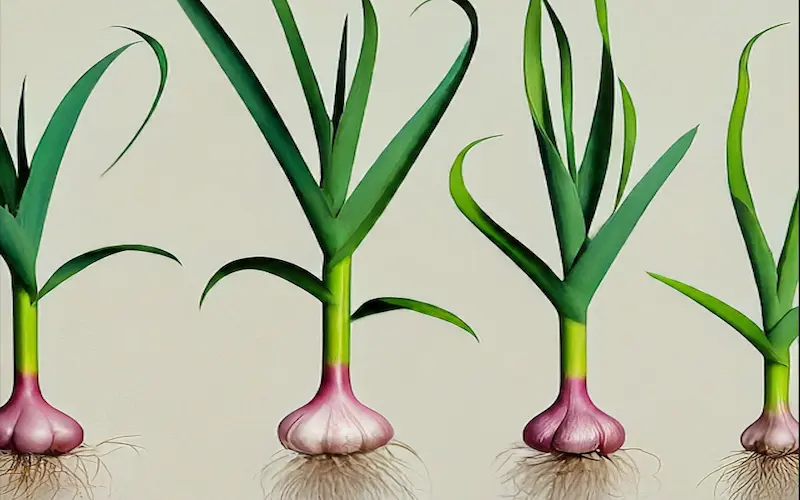
Garlic Flowering Stage
It is a critical phase in the life cycle of garlic plants. During this stage, the garlic plant produces a stalk known as a ‘scape’, eventually developing into a flower. Garlic flowers are a lovely sight and a sign that the plant is growing and that its bulbs will soon be ready for harvest.
It is usually advised to cut off these scapes so the plant can concentrate its energy on developing bulbs, resulting in larger, higher-quality bulbs. The garlic flowering stage holds significant importance in the garlic cultivation process.

Bulb Formation Stage
Following the vegetative stage, garlic plants begin the exciting phase of bulb formation. In this stage, the energy accumulated in the leaves is transformed into a new garlic bulb.
As daylight hours lengthen or shorten, depending on the variety, garlic plants receive the signal to start diverting resources from leaf growth to bulb development. During this time, the balance of nutrients shifts; phosphorus and potassium become more critical for encouraging bulb growth and strength.
The soil’s role remains paramount, as it must provide nutrients while allowing for adequate drainage. At this point, I usually ease up on nitrogen fertilization to prevent excessive leaf growth that could divert energy away from the bulbs.
Regular observation of the plants can give clues to the development of the bulbs. As they swell, the soil may crack around the base of the stems, and the lower leaves may start to yellow, indicating that the plant’s energy is channelled into the bulb.
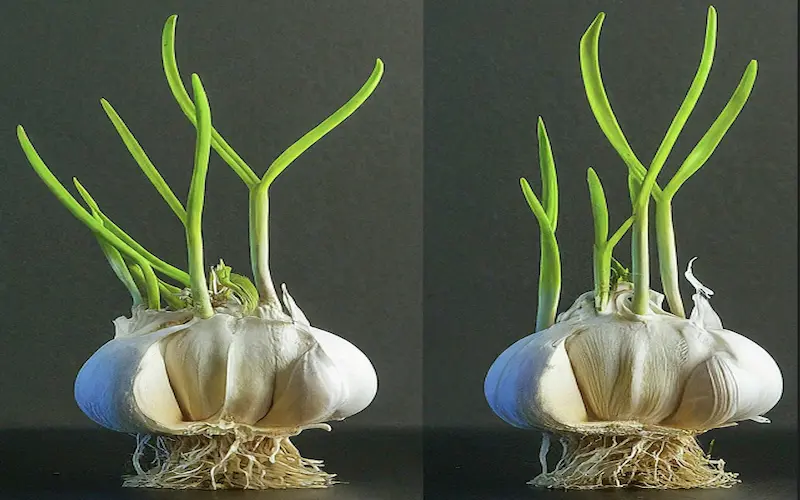
Maturation Stage
After bulb formation, garlic enters the maturation stage, where the focus is on allowing the bulbs to develop and harden in preparation for harvest fully. This is a less active stage for the gardener but no less critical.
Watering practices change during maturation. As bulbs near readiness, it’s advisable to reduce watering to allow them to begin the drying process. This is especially important for hardneck varieties, where excess moisture late in the season can affect the storage quality of the bulbs.
This is also the time to remove the garlic scapes from hardneck varieties. The scapes are the flower stalks that emerge from the centre of the plant. Cutting them off directs the plant’s energy back into bulb growth, potentially increasing the final size of the harvested garlic.
As the leaves begin to brown from the bottom up, it’s a sign that the bulbs are nearing full maturity. Patience is critical during this stage, as harvesting too early can result in underdeveloped bulbs while waiting too long can lead to over-mature bulbs that don’t store well.
.
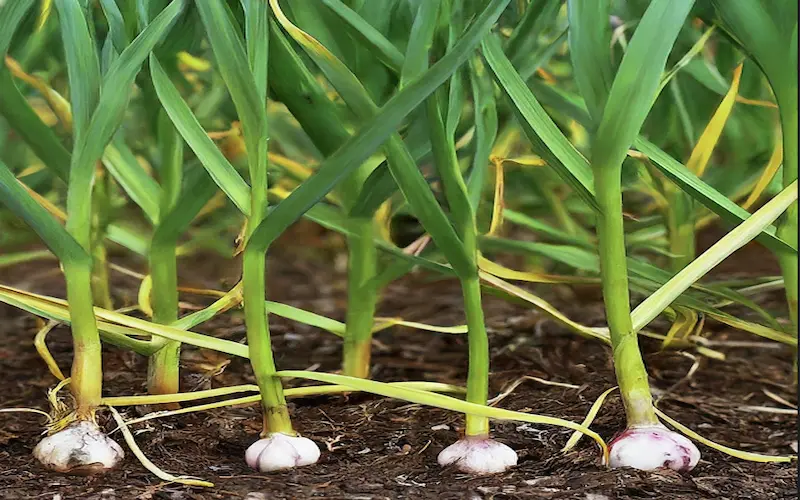
Harvesting Stage
The harvesting phase culminates all the hard work through the garlic growing stages. Timing is everything when it comes to pulling garlic from the ground.
When to Harvest Garlic
A general rule of thumb is to harvest when approximately one-third to one-half of the leaves have turned brown. This indicates that the bulbs have reached full size and the skins are thick enough to protect the cloves during storage.
Harvesting should be done carefully to avoid damaging the bulbs. I prefer using a garden fork to loosen the soil around the plants before gently lifting them. Once harvested, the garlic must be cured in a dry, ventilated area for several weeks. This process allows the outer layers to dry out, forming the protective papery skin that extends shelf life.
The sense of achievement I feel when I see the rows of curing garlic, knowing that I’ve guided them through each growth stage, is immense. It’s a testament to the careful attention and nurturing provided throughout the growing season.
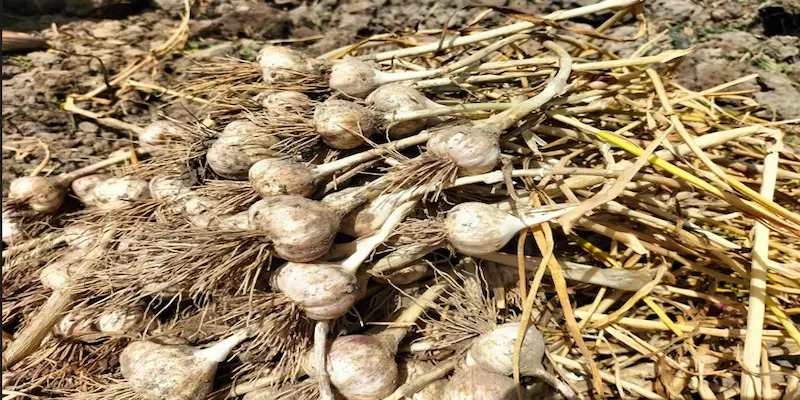
.
Curing Stage
Post-harvest, garlic bulbs are cured for several weeks in a dry, well-ventilated area. Curing is essential for long-term storage, as it allows the outer layers of the bulb to dry out, forming a protective covering.
Table Summarizing Garlic Growth Stages
| Stage | Description | Key Considerations |
| Planting | Planting individual cloves in well-prepared soil. | Proper depth and spacing are crucial. |
| Germination | Development of roots and emergence of shoots. | Maintain adequate moisture and protect from cold. |
| Leaf Development | Vigorous growth of leaves in spring. | Ensure full sunlight and good soil conditions. |
| Bulb Formation | Energy shifts from leaves to bulb development. | Adequate watering and nutrients are essential. |
| Maturation | Bulbs mature as leaves yellow and dry. | Monitor for the right harvest time. |
| Harvesting | Bulbs are harvested when mature. | Harvest timing is critical for optimal bulb size. |
| Curing | Bulbs are dried for storage. | Cure in a dry, ventilated area for several weeks. |
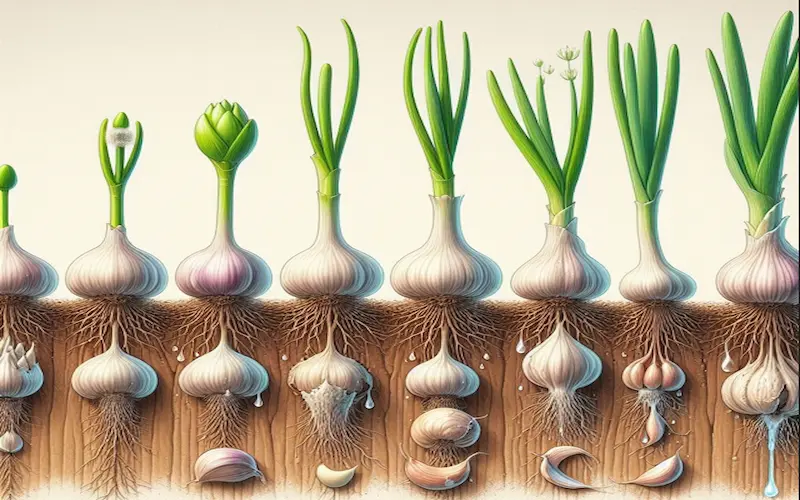
Common Challenges and Solutions
Pests and Diseases
Garlic, like any crop, is susceptible to certain pests and diseases. Identifying these problems early and implementing effective management strategies is crucial for maintaining a healthy crop.
Common Pests
- Onion Trips: These tiny insects feed on garlic leaves, causing them to become silvery and distorted. Control methods include using reflective mulch and applying insecticidal soaps or neem oil.
- Nematodes: Microscopic worms that attack garlic roots, leading to stunted growth and bulb deformation. Crop rotation and organic soil amendments can help manage nematode populations.
Common Diseases
- White Rot: A fungal disease causing yellowing and wilting of leaves and decay of roots and bulbs. To prevent white rot, practice crop rotation, avoid overwatering, and use clean, disease-free planting material.
- Botrytis Rot (Neck Rot): This fungus affects the neck and bulb, especially in wet conditions. Ensure good air circulation and avoid injuring the bulbs during cultivation and harvest.
Environmental Stress
Environmental factors significantly influence garlic growth. Understanding and mitigating these factors can enhance crop success.
Temperature Stress
- Cold Injury: Garlic is generally cold-hardy, but extreme cold without adequate snow cover can damage the crop. Mulching provides insulation against severe cold.
- Heat Stress: High temperatures, particularly during bulb development, can inhibit bulb growth. Mulching helps regulate soil temperature, and adequate irrigation prevents heat stress.
Water Stress:
- Overwatering: Garlic does not tolerate waterlogged soils, which can lead to root rot. Ensure well-drained soil and water appropriately.
- Drought: Prolonged dry periods can affect bulb size. Regular watering, especially during dry spells, is crucial.
Wind and Physical Damage:
- Strong winds can damage garlic leaves and stems. Planting in a sheltered location or using windbreaks can help protect the crop.
- Physical damage from cultivation tools can invite pests and diseases. Gentle handling during weeding and harvesting is important.
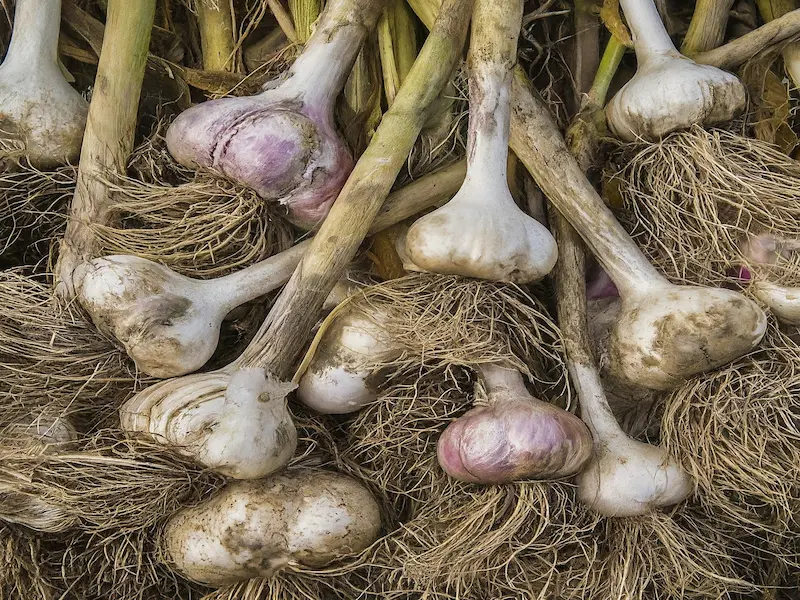
Advanced Tips for Optimal Growth
Here is a table with some advanced tips on fertilization strategies and watering techniques to achieve optimal growth of garlic:
| Aspect | Simple Tips for Best Growth |
| Fertilization Strategies | Regular Watering: Keep the soil moist but not too wet. About 1 inch of water per week. Avoid Too Much Water: Too much water can harm the plants. Make sure your soil drains well. Drip Irrigation: This method delivers water right to the roots efficiently. Less Water before Harvest: Cut down on watering when the leaves start turning yellow, a few weeks before you plan to harvest. |
| Watering Techniques | Regular Watering: Keep the soil moist but not too wet. About 1 inch of water per week.Avoid Too Much Water: Too much water can harm the plants. Make sure your soil drains well. Drip Irrigation: This method delivers water right to the roots efficiently. Less Water before Harvest: Cut down on watering when the leaves start turning yellow, a few weeks before you plan to harvest. |
Questions and answers related to Garlic growing stages.
The optimal time to harvest garlic depends on the plant’s specific growth patterns. Garlic is typically ready for harvest when the lower leaves begin to brown, and the upper leaves are still green, usually between late spring and mid-summer. Monitoring your garlic plants closely is crucial as over-matured garlic may split open, making it less suitable for storage. Moreover, harvesting too early can result in undersized bulbs. Therefore, understanding these key indicators can assist growers in determining the appropriate time to harvest garlic, thereby ensuring a high-quality yield.
Yes, garlic can be successfully grown in containers. Choose a pot at least 8-10 inches deep with good drainage. Ensure it’s large enough to provide adequate space between cloves.
Garlic typically takes about 6 to 9 months to grow from planting to harvest, depending on the variety and growing conditions.
The growth stages of garlic involve several distinct phases. It begins with sprouting, where the cloves planted in the soil send out shoots. Following this, leaf growth occurs, characterized by developing green foliage above the soil. As the plant matures, it enters the bulb formation stage, where the garlic bulbs form underground. Finally, the garlic reaches maturation, marked by the bulbs reaching their full size and the leaves starting to dry out and turn brown. Harvest typically occurs shortly after this stage to ensure optimal flavor and storage quality.
When growing, garlic appears as tall, slender green shoots emerging from the soil, resembling green onions or scallions.
Garlic Gardening: Unearthing the Joys of Garlic Growing Your Own
Growing garlic is a rewarding experience that brings you closer to nature. Whether you’re a seasoned gardener or a beginner, the world of garlic cultivation offers a fulfilling adventure. With the knowledge and tips shared in this post, you’re well-equipped to start your garlic-growing journey. So, plant that first clove and watch the magic unfold!

- Be Respectful
- Stay Relevant
- Stay Positive
- True Feedback
- Encourage Discussion
- Avoid Spamming
- No Fake News
- Don't Copy-Paste
- No Personal Attacks



- Be Respectful
- Stay Relevant
- Stay Positive
- True Feedback
- Encourage Discussion
- Avoid Spamming
- No Fake News
- Don't Copy-Paste
- No Personal Attacks
